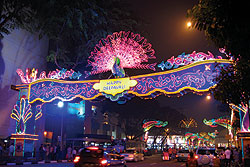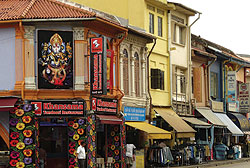|
Little India is an ethnic neighbourhood found in Singapore that has
Tamil cultural elements. Little India lies east of the
Singapore River—across from Chinatown, located west of
the river—and north of Kampong Glam. Both areas are part
of the urban planning area of Rochor. It is more commonly
known as Tekka in the local Tamil community.
Little India is distinct from the Chulia Kampong area, which, under the
Raffles Plan of Singapore, was originally a division of
colonial Singapore where Tamil immigrants would reside
under the British policy of ethnic segregation. However,
as Chulia Kampong became more crowded and competition for
land escalated, many ethnic Tamils moved into what is now
known as Little India. (The Chulia Kampong district no
longer exists as a distinct area.)
The Little India area developed around a former settlement for Tamil
convicts. Its location along the Serangoon River
originally made it attractive for raising cattle, and
trade in livestock was once prominent in the area.
Eventually, other economic activities developed, and by
the turn of the 20th century, the area began to look like
a Tamil ethnic neighbourhood.
 Although ethnic Tamils no longer tend to stay solely
segregated in one place as previously arranged under the
modern People's Action Party (PAP) policy of racial
harmony, for the sake of cultural heritage, many of their
commercial or cottage industry units are concentrated in
Little India. Tamil-dominant commercial zones are also
found in HDB estates. This neighbourhood has the patronage
of people of all races who wish to eat or buy something
specific to Tamil culture, such as curry or Tamil
clothing. One of the more prominent examples of
cross-cultural patronage (besides those eating out in the
area) is that many Chinese parents go to shops in Little
India to grind rice to make congee for infants. Here shops
have machinery primarily meant to grind spices into powder
for use in Tamil cuisine. Little India resembles India in
many respects, including road construction and sanitation,
differing sharply from the rest of Singapore's other
districts. Although ethnic Tamils no longer tend to stay solely
segregated in one place as previously arranged under the
modern People's Action Party (PAP) policy of racial
harmony, for the sake of cultural heritage, many of their
commercial or cottage industry units are concentrated in
Little India. Tamil-dominant commercial zones are also
found in HDB estates. This neighbourhood has the patronage
of people of all races who wish to eat or buy something
specific to Tamil culture, such as curry or Tamil
clothing. One of the more prominent examples of
cross-cultural patronage (besides those eating out in the
area) is that many Chinese parents go to shops in Little
India to grind rice to make congee for infants. Here shops
have machinery primarily meant to grind spices into powder
for use in Tamil cuisine. Little India resembles India in
many respects, including road construction and sanitation,
differing sharply from the rest of Singapore's other
districts.
 Serangoon Road is the main commercial thoroughfare in Little India. It
intersects Rochor Canal Road and Bukit Timah Sungei Road.
Along Serangoon Road is the Tekka Centre, the Tekka Mall,
the Little India Arcade, Serangoon Plaza, and the Mustafa
Centre (on a side-road). Farrer Park Fields is located in
the district. Several Hindu temples, mosques, and other
places of worship include Foochow Methodist Church,
Kampong Kapor Methodist Church, Sri Veeramakaliamman
Temple, Angullia Mosque, Sri Vadapathira Kaliamman Temple,
Jalan Mosque, and the Central Sikh Gurdwara. The Abdul
Gafoor Mosque, built in 1859 and named after a Tamil
lawyer's clerk, features Arabian and Renaissance-style
architecture. Its prayer hall, decorated with Moorish
arch-work, displays a tableau featuring the history of the
Islamic religion. The Sri Srinivasa Perumal Temple, along
Serangoon Road, features a high gopuram (tower), and was
built in 1855. The Buddhist Sakyamuni Buddha Gaya Temple,
also along Serangoon Road, was established by Thai monk
Vuthisasara in 1927. Leong San See Temple is dedicated to
Guanyin, the Chinese Boddhisattva of Mercy. Serangoon Road is the main commercial thoroughfare in Little India. It
intersects Rochor Canal Road and Bukit Timah Sungei Road.
Along Serangoon Road is the Tekka Centre, the Tekka Mall,
the Little India Arcade, Serangoon Plaza, and the Mustafa
Centre (on a side-road). Farrer Park Fields is located in
the district. Several Hindu temples, mosques, and other
places of worship include Foochow Methodist Church,
Kampong Kapor Methodist Church, Sri Veeramakaliamman
Temple, Angullia Mosque, Sri Vadapathira Kaliamman Temple,
Jalan Mosque, and the Central Sikh Gurdwara. The Abdul
Gafoor Mosque, built in 1859 and named after a Tamil
lawyer's clerk, features Arabian and Renaissance-style
architecture. Its prayer hall, decorated with Moorish
arch-work, displays a tableau featuring the history of the
Islamic religion. The Sri Srinivasa Perumal Temple, along
Serangoon Road, features a high gopuram (tower), and was
built in 1855. The Buddhist Sakyamuni Buddha Gaya Temple,
also along Serangoon Road, was established by Thai monk
Vuthisasara in 1927. Leong San See Temple is dedicated to
Guanyin, the Chinese Boddhisattva of Mercy.
Little India's Petain Road, named after French Marshal
Philippe Pétain (who was later convicted of collaboration
with Nazi Germany), was built in 1916 on a drained swamp,
and features examples of Singaporean Chinese architecture.
Little India is, as the name promises, the center for the
large Indian community in Singapore. While a rather
sanitized version of the real thing, Little India retains
its distinct identity without degenerating into a mere
tourist attraction and is one of the most colorful and
attractive places to visit in Singapore.
The North-East MRT line's Little India and Farrer Park
stations, near Serangoon Road, are convenient entry points
into the area. Bugis station on the East-West line is also
within walking distance.
Getting taxis in Little India can be difficult, especially
on weekends. It's best to either book by phone or head to
the major roads on the edges to flag one down.
Get
around:
Little India's main drag is Serangoon Road, which starts
at Rochor Canal Road and continues northward to Serangoon
itself. The action is tightly concentrated a few blocks on
either side of the road, and can be easily covered on
foot.
Little India's primary attraction is the town itself. Here
too you can find the brightly painted shophouses that are
an icon of Singapore, but now most of the Tamil signs have
almost disappeared and have been replaced with Hindi,
Bengali and other Indian scripts. Stores hawk saris and
gold bangles, spices and incense waft in from the doorways
and Bollywood's latest soundtracks blare from every other
alley.
Sri Veeramakaliamman Temple, 141 Serangoon Road is Little
India's busiest and oldest temple, dating back to
1881—although the present structure was completed in
1986. The temple is particularly busy on Tuesdays, Fridays
and Sundays. The most extreme thing to do in Little India
is to join the festival of Thaipusam, held yearly during
the full moon in the lunar month of Thai (usually
January/February). Male devotees attach ornate shrines to
their flesh with piercing hooks known as askavadi and walk
across town in a day-long procession. Female devotees
would usually just carry a pot of milk on their head and
join the procession. The procession starts from Sri
Srinivasa Perumal Temple in Serangoon Road and proceeds to
the Sri Thandayuthapani Temple on Tank Road.
Around Deepavali, the Hindu festival of light, Serangoon
Road is festively decorated (with lights, of course!) and
open-air markets are set up to sell Deepavali goodies.
Like Thaipusam, the exact date is set by the lunar
calendar, but it takes place in October/November and is a
public holiday. Near the beginning of Deepavali, the fire
walking festival of Thimithiis is held, where many male
devotees will walk across a platform of burning coal.
Though the actual fire walking takes place at the Sri
Mariammam temple in Chinatown, the procession starts at
the Sri Srinivasa Perumal Temple in Serangoon Road and
makes its way to Chinatown early in the morning where the
fire walking commences.
Also at this time, every Sunday evening half-a-million
workers from the subcontinent turn up in Little India to
hang out on their day off. Most of the crowd is friendly
enough, but at times things can go a bit out of control.
There is enough security though at such times to take care
of any eventuality.
|